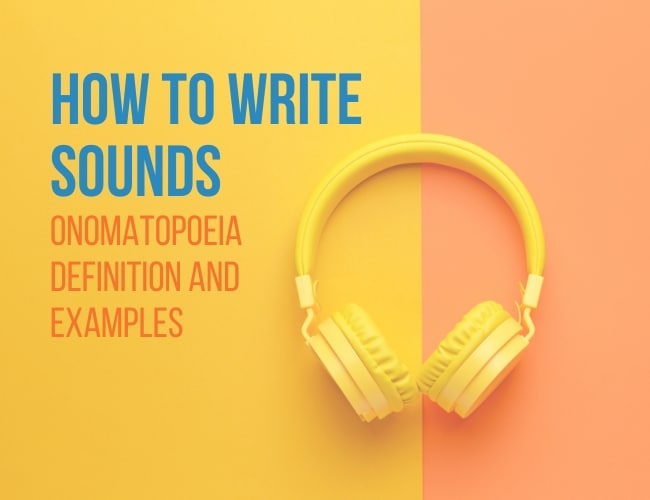The article How To Write Sounds: Onomatopoeia Definition and Examples appeared first on The Write Practice.
Screech! Hold up. Did you hear that? Boom! No, not that. Ring-ring. Not that either. Moo. There it is.
That is the sound of onomatopoeia, one of the most fun words to spell in the English language, and if you want to know how to write sounds, an absolutely essential literary device.
How does onomatopoeia work? And how can you use it to write sounds? In this article, I’ll give you the definition of onomatopoeia, share a list of onomatopoeia examples, and end with a creative writing exercise.
Onomatopoeia Definition
Onomatopoeia. A word that sounds like the sound it describes, e.g. bang, boom, pow.
How to Write Sounds with Onomatopoeia
Adding onomatopoeia to your writing engages the reader’s imagination and forces them to mentally say that word, invoking the image or sound effect that you’re trying to get across.
When you’re writing, you may want the reader to hear the sound of gravel crunching beneath a character’s feet.
James walked across the gravel driveway, his boots crunching with each step.
Not the best story I’ve ever told, but you get the idea, right? Onomatopoeia tries to capture the natural sounds that emerge from character action or setting detail.
It doesn’t have to be a poetic sound or a pleasant sound—the goal is to capture image.
To add onomatopoeia to your writing, pay attention to sounds around you. Is a faucet dripping? Or maybe you can hear the woosh of cars as they fly by on the freeway beside your house.
Whatever you hear, try to capture it in a writing sound or a kind of sound effect for your reader.
Use Onomatopoeia to Describe Animal Sounds
Onomatopoeias is often used to describe the sounds animas make, like “oink” or “moo.”
My favorite recent example of onomatopoeia is a humorous song about the sound a fox makes called “What Does a Fox Say” by the Norwegian group Ylvis.
Dog goes “woof”
Cat goes “meow”
Bird goes “tweet”
And mouse goes “squeek”
Cow goes “moo”
Frog goes “croak”
And the elephant goes “toot”
Ducks say “quack”
And fish go “blub”
And the seal goes “ow ow ow”But there’s one sound
That no one knows
What does the fox say?
Different languages have their own onomatopoeias as well. For example, American dogs say “woof woof,” but French dogs say “ouah ouah,” and Japanese dogs say “wan wan.”
Make Up New Words With Onomatopoeia
Going back to our example:
James walked across the gravel driveway, his boots crunching at each step.
You could use the word crunch, which is a great example of onomatopoeia.
But if you wanted to take onomatopoeia a step further you could alter the word, or even make up a new word, to describe the sound. For example, say you have a very specific idea of what that sound is, so instead of saying that the gravel crunched, maybe you make up a word that, when spoken aloud, sounds like the gravel. Crinch or shimpch or even stomp-ch.
Onomatopoeia is, with a few exceptions, the one time when you’re writing that no one will correct your spelling!
List of Onomatopoeia Examples
Here’s a list of some of the top onomatopoeia examples:
- baa
- bang
- boom
- cheep
- clack
- cluck
- crack
- crunch
- giggle
- groan
- haha
- hee hee
- moo
- quack
- ring
- slam
- smack
- stomp
- thwack
- tinkle
- toot
- tweet
- wham
- woosh
- wow
Whichever examples of onomatopoeia strike you as the best description for your action, try a few today and see how they enliven the scene.
What is your favorite onomatopoeia sound word? Are there any onomatopoeia words I forgot? Let me know in the comments.
PRACTICE
Ready to put onomatopoeia to use? Great! Here’s your creative writing prompt:
Write for fifteen minutes about a group of friends experiencing the last few days of summer. Incorporate as many onomatopoeias as you can.
Share your practice in the Pro Practice Workshop here, and leave feedback for a few other writers. Not a member? Join us here.
The article How To Write Sounds: Onomatopoeia Definition and Examples appeared first on The Write Practice. The Write Practice – The Online Writing Workbook
Go to Source
Author: Joe Bunting

